Related Research Articles
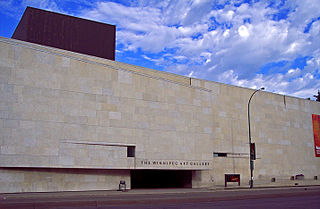
The Winnipeg Art Gallery (WAG) is an art museum in Winnipeg, Manitoba, Canada. Its permanent collection includes over 24,000 works from Canadian, Indigenous Canadian, and international artists. The museum also holds the world's largest collection of Inuit art. In addition to exhibits for its collection, the museum has organized and hosted a number of travelling arts exhibitions. Its building complex consists of a main building that includes 11,000 square metres (120,000 sq ft) of indoor space and the adjacent 3,700-square-metre (40,000 sq ft) Qaumajuq building.

The Office for Metropolitan Architecture (OMA) is an international architectural firm with offices in Rotterdam, New York, Hong Kong, Doha, and Australia. The firm is currently led by eight partners - Rem Koolhaas, Reinier de Graaf, Ellen van Loon, Shohei Shigematsu, Iyad Alsaka, Chris van Duijn, Jason Long, and managing partner and architect David Gianotten.

The Manitoba Museum, previously the Manitoba Museum of Man and Nature, is a human and natural history museum in Winnipeg, Manitoba, as well as the province's largest, not-for-profit centre for heritage and science education.
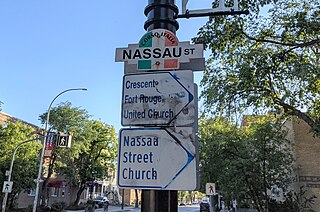
Nassau Street is a 2-kilometre (1.2 mi) street in Winnipeg, Manitoba, located partially within the Osborne Village and Fort Rouge neighbourhoods.
Alexander Pilis is an architectural investigator, working under the aegis of "Architecture Parallax".

The Assiniboine ParkPavilion is a landmark building at Assiniboine Park in Winnipeg, Manitoba, Canada. It is today one of Winnipeg's most familiar landmarks.
Étienne-Joseph Gaboury was a Canadian architect from Winnipeg, Manitoba. He was noted for designing key buildings in his hometown, such as the Royal Canadian Mint building, Esplanade Riel, Saint Boniface Cathedral, and the Precious Blood Church, and was regarded as the province's greatest architect.

The World Architecture Festival (WAF) is an annual festival and awards ceremony, one of the most prestigious events dedicated to the architecture and development industry. The first four events were held in Barcelona, from 2008 to 2011, at which point the festival moved to Singapore for four years. Since 2016, host cities have included Berlin and Amsterdam. It is the only event where around 550 shortlisted architects present their projects live in crit rooms to a judging panel. One of these projects is awarded the World Building of the Year title. Each year the World Architecture Festival publishes a list of the winners of the awards on their official website.
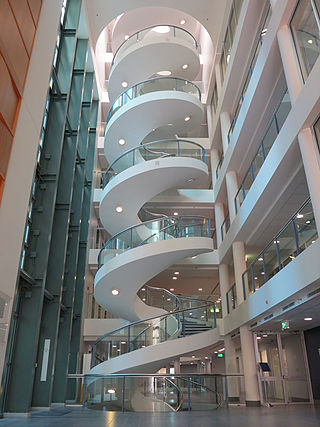
Kenneth Frank Charles Woolley, AM B Arch, Hon DSc Arch Sydney LFRAIA, FTSE, Architect, was an Australian architect. In a career spanning 60 years, he is best known for his contributions to project housing with Pettit and Sevitt, four time Wilkinson Award-winning architect, including three times for his own house, the first being the 1962 Woolley House in Mosman, and his longstanding partnership with Sydney Ancher and Bryce Mortlock. He is regarded as being a prominent figure in the development of the Sydney School movement and Australian vernacular building.
Teeple Architects is an architecture firm based in Toronto, Ontario founded by Stephen Teeple, in the year 1989. The firm is known to design several buildings in Canada, that focus on urban development, and sustainable design.
KPMB is a Canadian architecture firm founded by Bruce Kuwabara, Thomas Payne, Marianne McKenna, and Shirley Blumberg, in 1987. It is headquartered in Toronto, where the majority of their work is found. Aside from designing buildings, the firm also works in interior design. KPMB Architects was officially renamed from Kuwabara Payne McKenna Blumberg Architects to KPMB Architects on February 12, 2013.

5468796 Architecture is a Winnipeg-based architecture practice founded in 2007. The practice name incorporates its company registration number.
Patkau Architects is an architecture firm based in Vancouver, British Columbia, Canada. It is a full-service firm practicing in Canada and the United States. Its project scope includes, but is not limited to, gallery installations, art galleries, libraries, university buildings, urban planning and private residences. The firm has received numerous national and international architectural awards. Patkau Architects also represented Canada at the Venice Biennale in 2006.
The year 2018 in architecture involved some significant architectural events and new buildings.
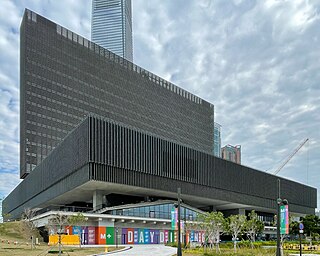
M+ is a museum of visual culture in the West Kowloon Cultural District of Hong Kong. It exhibits twentieth and twenty-first century visual culture encompassing visual art, design and architecture, and moving image. It opened on 12 November 2021.

Isadore "Issie" Coop (1926–2003) was a Canadian architect and a Fellow of the Royal Architectural Institute of Canada, with a reputation for highly functional, cost-effective architecture. A student of the famed American-German architect Ludwig Mies van der Rohe, Coop brought the Miesian style to Winnipeg, and changed the face of Winnipeg architecture, according to one writer.
Sasa Radulovic is a Bosnian Canadian architect and co-founding partner of 5468796 Architecture - an award-winning Canadian firm from Winnipeg. His firm is known for affordable, highly innovative, urban architectural projects, which include institutional, commercial and residential structures.
Ernest John Smith was a Canadian architect.
David Paul Penner, MAA, FRAIC was a Canadian architect, born and raised in the Osborne Village neighbourhood of Winnipeg, Manitoba. He attended the University of Manitoba where he received his Bachelor of Environment Studies in 1979 and Masters of Architecture in 1985. Penner was the founding principal of David Penner Architect (DPA). He became a Fellow of the RAIC in 2012, and was involved in several organizations outside his firm including Storefront Manitoba and the Prairie Design Awards Program. His best-known architectural works include Fountain Springs Housing, Buhler Center, Windsor Park Library, and Mere Hotel. Penner died from a heart attack on January 7, 2020.
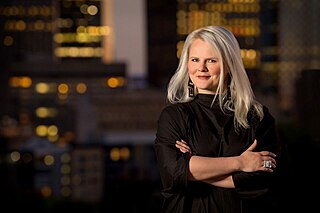
Johanna Hurme is a co-founding and Managing Partner of the Winnipeg-based studio, 5468796 Architecture, which she leads with Sasa Radulovic and Colin Neufeld. Through her leadership the practice strives to address architectural and civic issues - from city building to contemporary habitation - through inventive solutions engaging design and collaborative experiences to create outstanding architecture irrespective of budget.
References
- ↑ Order of Canada citation
- ↑ "Queen Elizabeth II Diamond Jubilee Medal". Archived from the original on 2012-12-04.
- 1 2 3 4 5 6 "Gustavo da Roza". Winnipeg Architecture Foundation. Retrieved 7 August 2022.